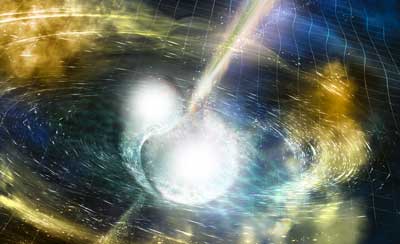| Dec 12, 2019 |
|
|
|
(Nanowerk News) Scientists are getting better at modeling the complex tangle of physics properties at play in one of the most powerful events in the known universe: the merger of two neutron stars.
|
|
Neutron stars are the fast-spinning, ultradense husks of larger stars that exploded as supernovae. They measure about 12 miles across, and a single teaspoon of neutron star matter weighs as much as 1,125 Golden Gate bridges, or 2,735 Empire State buildings.
|
 |
| Artists illustration of two merging neutron stars. The rippling space-time grid represents gravitational waves that travel out from the collision, while the narrow beams show the bursts of gamma rays that are shot out just seconds after the gravitational waves. Swirling clouds of material ejected from the merging stars are also depicted. The clouds glow with visible and other wavelengths of light. (Image: NSF/LIGO/Sonoma State University/A. Simonnet)
|
|
On Aug. 17, 2017, scientists observed a signature of gravitational waves ripples in the fabric of space-time and also an associated explosive burst, known as a kilonova, that were best explained by the merger of two neutron stars. And again on April 25, 2019, another likely neutron-star-merger event, based solely on a gravitational wave measurement.
|
|
While these events can help to compare and validate the physics models that researchers develop to understand whats at work in these mergers, researchers must still essentially start from scratch to build the right physics into these models.
|
|
In a study published in the Monthly Notices of the Royal Astronomical Society journal (“The role of magnetic field geometry in the evolution of neutron star merger accretion discs”), a team led by scientists at Northwestern University simulated the formation of a disc of matter, a giant burst of ejected matter, and the startup of energetic jets around the remaining object either a larger neutron star or a black hole in the aftermath of this merger.
|
|
The team included researchers at the Department of Energys Lawrence Berkeley National Laboratory (Berkeley Lab), UC Berkeley, the University of Alberta, and the University of New Hampshire.
|
|
To make the model more realistic than in previous efforts, the team built three separate simulations that tested different geometry for the powerful magnetic fields encircling the merger..
|
|
Were starting from a set of physical principles, carrying out a calculation that nobody has done at this level before, and then asking, Are we reasonably close to observations or are we missing something important? said Rodrigo Fernández, a co-author of the latest study and a researcher at the University of Alberta.
|
|
The 3D simulations they carried out, which included computing time at Berkeley Labs National Energy Research Scientific Computing Center (NERSC), involved more than 6 million hours of CPU (computer processing unit) time.
|
|
The simulations account for GRMHD (general relativistic magnetohydrodynamics) effects, which include properties associated with magnetic fields and fluid-like matter, as well as the properties of matter and energy traveling at nearly the speed of light. Researchers noted that the simulations could also prove useful in modeling the merger of a black hole with a neutron star.
|
|
To simulate the kilonova outbursts an element-creating event that scientists believe is responsible for seeding space with heavy elements the team produced estimates of its total ejected mass, its average velocity, and its composition.
|
|
With these three quantities one can estimate whether the light curve would have the right luminosity, color, and evolution time, Fernández said.
|
|
There are two generalized components of these kilonova outbursts one evolves over the course of days and is characterized by the signature blue-frequency light it gives off at its peak, and the other lasts for weeks and has an associated color peak of near-infrared light.
|
|
|
|
The latest simulations are designed to model these blue and red components of kilonovae.
|
|
The simulations also help to explain the launch of powerful energy jets that emanate outward in the merger aftermath, including a striped character of the jets due to the effects of powerful, alternating magnetic fields. These jets can be observed as a burst of gamma rays, as with the 2017 event.
|
|
Daniel Kasen, a scientist in the Nuclear Science Division at Berkeley Lab and an associate professor of physics and astronomy at UC Berkeley, said, Magnetic fields provide a way to tap the energy of a spinning black hole and use it to shoot jets of gas moving at near the speed of light. Such jets can produce bursts of gamma-rays, as well as extended radio and x-ray emission, all of which were seen in the 2017 event.
|
|
Fernández acknowledged that the simulations dont precisely mirror observations yet the simulations showed a lower mass for the blue kilonova contribution compared to the red and that better models of the hypermassive neutron star resulting from the merger and of the abundant neutrinos ghostly particles that travel through most types of matter unaffected associated with the merger event are needed to improve the models.
|
|
The model did benefit from models of the discs of matter (accretion discs) circling black holes, as well as models of neutrino-cooling properties, the volume of neutrons and protons associated with the merger event, and the matter-creating process associated with the kilonova.
|
|
Kasen noted that computing resources at Berkeley Lab let us peer into the most extreme environments like this turbulent whirlpool sloshing outside a newly born black hole and watch and learn how the heavy elements were made.
|
|
The simulations suggest that the neutron-star merger observed in August 2017 likely did not form a black hole in its immediate aftermath, and that the strongest magnetic fields were donut-shaped. Also, the simulations largely agreed with some long-standing models for fluid behavior.
|


